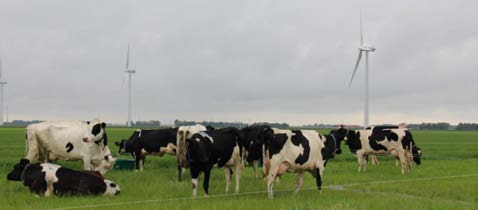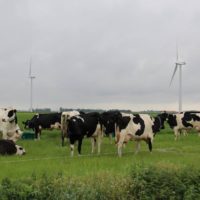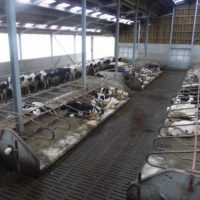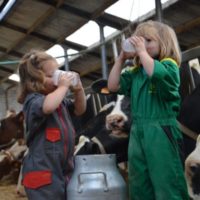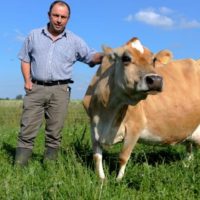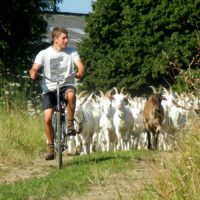Maximum milk from fresh grass
Farm: “Weidebedrijf Aeres Farms”
Location: Dronten, The Netherlands
Case study
 Maximum milk from fresh grass (.pdf)
Maximum milk from fresh grass (.pdf)
Description
Background
The Weidebedrijf (PastureBarn), the educational farm of Aeres Hogeschool in the city of Dronten in the Netherlands is an organic farm with a grazing system based on the Irish system: more milk from fresh grass with maximum grazing. Maximum grazing and more milk from fresh grass are realized through an intensive grazing management, strip stocking, and a spring calving herd.
The Weidebedrijf of the Aeres Farm currently has 60 Holstein dairy cows and 28 young cattle. It is not a family business, but it is an independent company that runs for research and educational purposes. The farm has a grazing platform of 45 ha light clay soil with an organic matter content of 4%. The grazing platform is classified as permanent grassland. The grazing platform is fully available for grazing. Next to several grazing cuts, it is on average mowed 1.5 times per year.
The machine park is very limited for Dutch conditions and consists of:
- Enricher
- 60 hp tractor
- Mower
- Rake
- Sprinkler device for spreading straw in the barn
- Manure scraper in the barn
- Milking parlour 2×14 swing over
- Feed cart (25% for the Weidebedrijf and 75% for the Flevoland barn, which is close to the Weidebedrijf)
The work at the Weidebedrijf is done by one employee and several students from different study programs, both from vocational schools and universities of applied sciences.
The barn at the Weidebedrijf is 40 meters by 75 meters large. There are 20 igloos available for the young stock. When the cows are in the stable in the winter, they are checked three to four times a day. The veterinarian visits on average once a month. The calves are dehorned. In some cases, there is more than 10% mastitis in the herd and ketosis occurs in more than 10% of the herd. Acidosis and milk fever are less common, with less than 10% of the herd. Parasites, infections and claw problems do not occur. All cows are artificially inseminated. The cattle are fed once a day. Their ration consists of grass. Concentrates are fed in the milking parlour. The water supply consists of tap water, which is provided via drinking bins both in the stable and on the pasture. The average milk production of the Weidebedrijf is 8200 liters per cow per year and the total milk production is 500.000 liters per year.
Detailed description
The innovation of the Weidebedrijf (PastureBarn) is that it uses a completely different grazing system than the average Dutch farmer. The farm was set up as a low-cost farm in 2015. The philosophy behind the system is that costs are reduced in every part of the farm and in this way, you will be able to earn money as a farmer. Full grazing is a key characteristic of this system. A second aim of the farm is to show the possibilities of this system to young agricultural students and entrepreneurs and show them the benefits of the system. The grazing system of the Weidebedrijf is inspired by turning a maximum amount of fresh grass into milk. The system is set-up to allow the cows to consume as much fresh grass as possible. In order to achieve this, the Weidebedrijf works with a spring-calving herd. The motto is: Let the cow do the work and use machinery as little as possible. You could say that the cow is used as a ‘contract worker’.
Results
The cows graze for about 22 hours per day during the majority of the grazing season and a little bit less in spring and autumn. The grazing season is about 240 days per year. The grazing platform is divided into plots of approximately 0.8 ha and every day a new plot is offered. The botanical composition of the grazing platform is a mixture of mainly perennial ryegrass and clover. The average yearly grass yield equals about 11 tons dry matter of grass per ha. About 4 tons per ha is cut for silage and about 7 tons is used as fresh grass for grazing of dairy cows. The fertilization consists of solid manure from the stable and slurry in a ratio of about 50/50.
The farmer evaluates the strategy of the Weidebedrijf positively. Results of the innovation are an efficient and intensive grazing system and limited costs. The strategy of the farmer is based on more milk from fresh grass with grazing. This works quite good. The cows currently produce 8200 liters per cow from fresh grass and only a limited amount of concentrates.
Adoption criteria
A very important observation made by the farmer is that when starting a different concept like the current one, it is crucial to stick to the plan. This is difficult at times, but what is the added value of a new concept if the idea soon deviates from the original plan? Perseverance and learning by doing are important.
The innovation is successful on this farm due to a number of reasons that interfere with each other:
- The availability of (scientific) knowledge, since the Weidebedrijf of Aeres Farms is closely connected to Aeres University of Applied Sciences.
- The Weidebedrijf is an educational farm for agricultural students. The farm/innovation has multiple purposes: a normal economic farming purpose but also a purpose for learning processes. The combined functions create the opportunity to innovate.
- The curiosity of the farm management and the students to try new methods.
For other farmers that would like to adopt this innovation, it is crucial to meet a few adoption criteria. The farmer needs to have a large grazing platform (in relation to their number of cows) and needs to have a grazing mind-set. Farmers need to be flexible in order to adjust grazing to fluctuating weather conditions.
Future prospects
From the farmer’s point of view, this system is in theory possible in many areas of the Netherlands. However, the corresponding and necessary grazing mind-set is often not available among Dutch farmers. Education is crucial to change the mind-set and to provide scientific knowledge about the benefits of this system. The Weidebedrijf makes a strong contribution in this area by educating a large group of young agricultural students and entrepreneurs.
Additional information
| Farming system | organic farming |
|---|---|
| Domains of innovation | farm system, grazing management system |
| Main types of animal | dairy cattle |
| Country | The Netherlands |
| Product type | Case study |
| Language | English |

